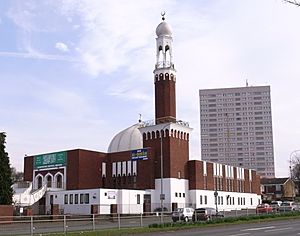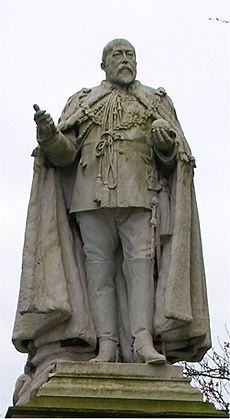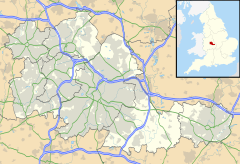Highgate, Birmingham facts for kids
Quick facts for kids Highgate |
|
|---|---|
 Birmingham Central Mosque |
|
| OS grid reference | SP0767585676 |
| Metropolitan borough | |
| Metropolitan county | |
| Region | |
| Country | England |
| Sovereign state | United Kingdom |
| Post town | BIRMINGHAM |
| Postcode district | B12 |
| Dialling code | 0121 |
| Police | West Midlands |
| Fire | West Midlands |
| Ambulance | West Midlands |
| EU Parliament | West Midlands |
| UK Parliament |
|
Highgate is an area in Birmingham, England. After a big plan in February 2008, Highgate became a part of Birmingham City Centre. Many people believe Highgate is where the city of Birmingham first began, way back in Anglo-Saxon times.
Birmingham Central Mosque is one of Highgate's most famous buildings. Today, Highgate has many shops and modern homes built by the local council. You can also find older buildings like Stratford House, the Church of St. Alban the Martyr, and large Victorian houses near Highgate Park.
Highgate is also home to the Birmingham Sports Centre and Joseph Chamberlain Sixth Form College. The Birmingham Sports Centre will be taken down, and a new Joseph Chamberlain Sixth Form College is being built at Haden Circus. You can find many small shops around Gooch Street.
Nearby areas include Lee Bank, Balsall Heath, Edgbaston, and Sparkbrook.
Contents
Highgate's Past: A Look at History
Most of Highgate was built after 1850. By 1900, about 15,000 people lived there. Today, the community is very mixed. This is because many people have moved here over the years, especially from countries in the Commonwealth.
Before the 1970s, many people from Bangladesh lived in Highgate. Most of them came from a rural area called Sylhet in the late 1950s and early 1960s. They chose Highgate because the homes were cheap, even if they were not in the best condition. A survey in 1971 found that most of them did not want to leave. One person from that time said:
Because of the crowding, my uncle and Abdul Jabbar bought the next door house. Soon the situation returned with a population of twenty or so in the two houses. Admittedly our houses were not always up to standard. We were all men, all working in heavy industry and all working overtime. When we came home we were already tired but had to do our cooking and cleaning. It was still "Home, Sweet Home" to us.
In the 1950s, Highgate was one of five areas around Birmingham city centre chosen for a big rebuild. The idea was to create "new towns" within the city. The other areas were Newtown, Lee Bank, Ladywood, and Nechells Green.
Highgate's Location and Landscape
How High is Highgate?
The western parts of Highgate are on the River Rea plain. This area is about 109 meters (358 feet) above sea level. As you move east, the land goes higher. It reaches about 135 meters (443 feet) at the Highgate Middleway, south of Leopold Street.
Getting Around Highgate: Transport and Roads
The Highgate Middleway (A4540) connects Camp Hill Circus and Haden Circus. Before 1851, there was a toll gate on Stratford Road called the Balsall Heath Gate. This gate collected money to help maintain the road.
Some streets in Highgate are named after the Vaughton family who lived there. For example, Dymoke Street was named after Mary Ann Dymoke, who was married to Robert Vaughton. Emily Street was named after their daughter-in-law.
Vaughton Street was built in the 1860s. By 1881, almost 1600 people lived there. The houses were originally back-to-back houses, meaning they shared back walls. They also had outdoor toilets and shared water taps. In 1938, the Council tore down these houses and built St. Martin's Flats. These flats were made of concrete because it was cheap, but this made them damp. The flats quickly got worse and were eventually knocked down in 1980. New private houses were built on the site in 1987.
Stanhope Street was called Ryland Street until 1881. Louisa Ryland was from one of Birmingham's richest families. She owned a lot of land in Birmingham, including parts of Highgate.

Highgate Park: A Green Space
Highgate Park is on land that used to belong to Elizabeth Hollier. She used it for grazing animals. When Elizabeth died, her will said the land should be used for charity. The four fields were to be rented out, and the money would be used to buy clothes for 24 poor people each year.
In 1875, the people in charge of Elizabeth Hollier's Charity wanted to build factories on the land. But the pasture had great views of the town. So, Birmingham Corporation bought the land instead and turned it into a public park with lawns, flower beds, and shrubs. Mayor of Birmingham, Joseph Chamberlain, officially opened the park on June 2, 1876. A bronze fountain was moved to the park from the Market Hall in 1880. Part of the park near Alcester Street was later paved to be a playground. Highgate Park was home to Birmingham's King Edward VII Memorial from 1951 until it was moved to Centenary Square in 2010.
Important Buildings in Highgate
Next to Highgate Park is the red brick building of the Rowton House Hotel. It was built in 1903–4 as a Rowton House hostel for single working men. It became a hotel in the 1990s. This building is a listed building called Parkview House. It has round towers at the corners with copper roofs shaped like cones. There are also terracotta figures of dragons holding shields around the top floor. The entrance on Alcester Street is also made of terracotta. It has carvings of boys that represent industry and farming.
On Moseley Street, next to the Rowton House Hotel, is a former police barracks built around 1880. It is now used as a hostel.
Stratford House is a very old building, dating back to 1601. It is a Grade II* listed building and is near the Camp Hill traffic island.
Samuel Heath & Sons started as a company that made things from brass. They have been at the Cobden Works on Leopold Street since 1820. Their office building was built in 1888 and is also listed for its interesting architecture and history.
Next to St Albans Church on Conybere Street are Lench's Trust almshouses and the warden's house. These were built in 1879 and designed by J A Chatwin.
Schools in Highgate
- Ark St Alban's Academy
- Calthorpe Special School
- Chandos Primary School
- Percy Shurmer Academy
- St Anne's Primary School
St Alban’s Church and School
James Samuel Pollock and his brother Thomas Benson Pollock were Anglo-Catholics. They built a church and school together on Leopold Street in 1865. The first church building was used as a boys' school after the current St Alban the Martyr church was built in 1881. A girls' school was also set up on Dymoke Street.
Famous People from Highgate
- Edward White Benson, who became an Archbishop of Canterbury
- William Mosedale, who received the George Cross medal



